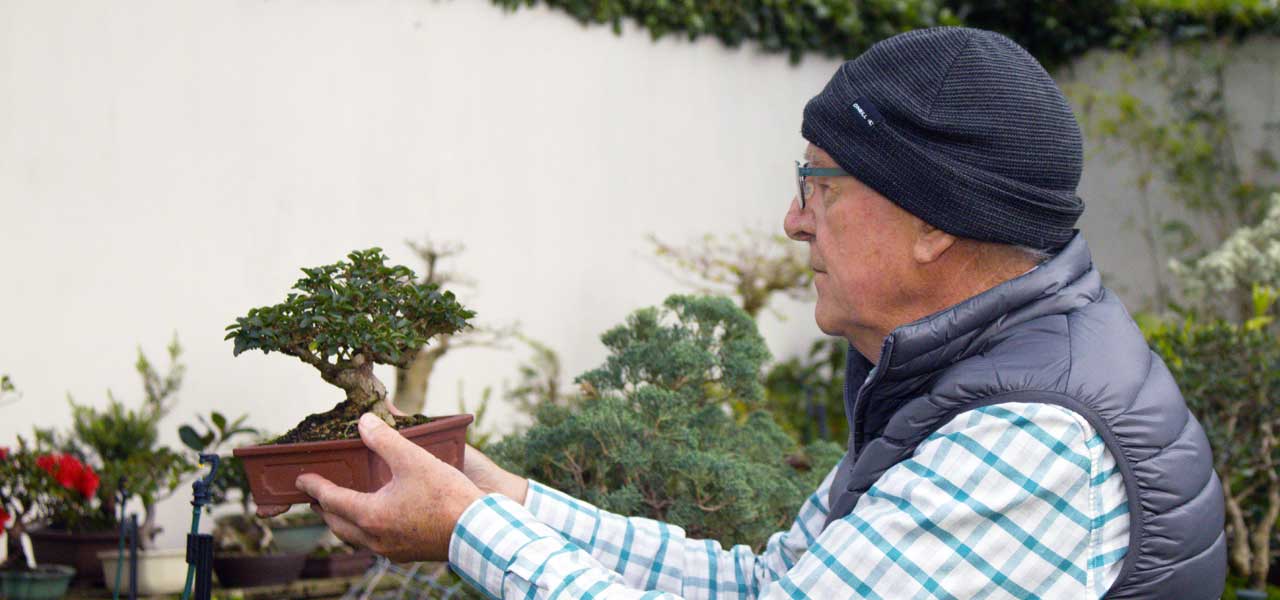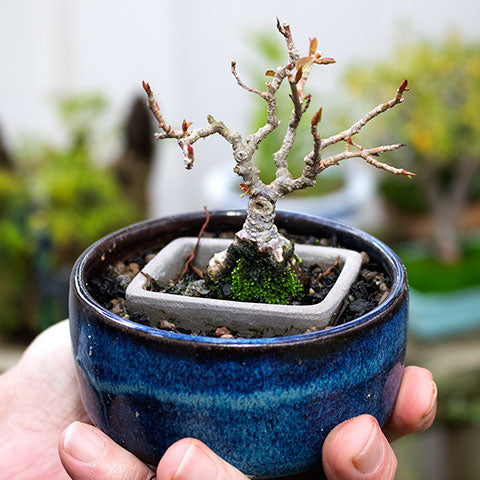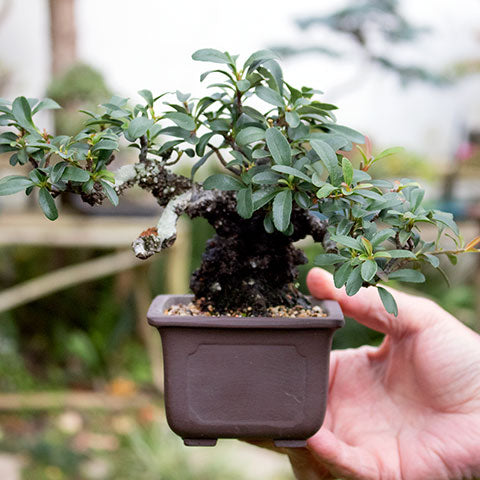Your Cart is Empty
spend R1000. 2kg or less. free shipping.
Menu

spend R1000. 2kg or less. free shipping.
bonsai
gardening
Orchids

Introduction to Miniature Bonsai
8 min read
Article written by Hennie Nel
Styling
The art of creating miniature bonsai is to create a small tree that one can envisage in nature, which has the maturity to justify its existence as an established tree that has been growing for many years.
The smaller the bonsai the less material such as branches, trunk and such you have to work with or said differently; the smaller your canvas. This presents an artistic challenge to the grower as they need to maximize use of all the available components to create the image they imagine. The nebari, trunk, and branches all play a vital role in the successful development. For example; selecting the best front might require a compromise on how the nebari is viewed, but the end result is better or greater visual taper or enhanced trunk movement.

Portulacaria Afra or (Spekboom, Porkbush or Elephant's Food) in an African style by the author.
The artist should also bear in mind that miniature bonsai are displayed in groups as a composition, rather than singular trees. To present an effective display, a fair quantity of suitable trees in a variety of styles, species, deciduous, evergreen will be needed from which to draw the final selection for display.
Classification
Miniature Bonsai are divided into categories. The following table was compiled by the Japanese Nippon Bonsai Association at the request of the UK bonsai society.
- Komono: one handed- 15-25 cm
- Shohin: one handed 13-20cm
- Mame: palm size 5-15cm
- Shito: fingertip size -5-10cm
- Keshitsubo: poppy-size 3-8cm
These measurements are only meant as guidelines and you should confirm the measurements with the organisers of any competition or exhibition beforehand should you wish to submit an entry. It would be great though and is strongly recommended that everyone would adhere to these guidelines so as to eliminate confusion and frustration.
All measurements are currently from the rim of the pot to the apex of the tree.
Maintenance
Watering
The small containers used in miniature bonsai cultivation severely limits the amount of soil or growing media your tree can form roots into. The rather obvious implications of this are that watering can be more demanding; up to three times a day in the hottest or driest periods.
For most it is impractical to water so many times and thus a humidity tray comes in very handy. These trays serve to insure that the trees remain most and that the roots do not dry out completely.

Double potted Ficus burtt-davyi (Scrambling fig or Veldvy).
Other methods of providing sufficient moisture to your trees might include “double-potting” them. Double potting simply entails placing your tree and its container into a 2nd, larger container. This action will support more vigorous growth and improved health. The roots which develop into the 2nd container can be trimmed from time to time. This technique or tip is especially handy when cultivating Shito sized bonsai as they can certainly dry out very quickly in particular weather conditions.
Light
Miniature bonsai should ideally be kept outdoors in an area which receives the not-so-harsh morning sun, especially if you want them to flower and fruit.
Fertilizing
Liquid fertilizer is a popular route as it is easy to apply. Generally a weaker dilution than suggested on the packaging is suggested and it should be applied more frequently such as weekly.
Solid fertilizer is very effective as it provides a constant source of nutrients to the tree however as the container is so small it can easily be washed off. Small fertilizer baskets solve this problem however, keeping the pellets or balls in place.
Other cultivation tips
Moss
Miniature bonsai, as with all other bonsai should be secured into the container with wire. This prevents them from being blown or otherwise knocked from their container and subsequently being stressed or even killed from drying out.
Although moss is appealing to us all, trees should be kept moss free on the trunk and nebari. Moss can cause rot on the trunk and roots as it remains wet for long periods. When mature trees have developed a fissured bark rotting of the attractive bark is of concern and if allowed to develop, moss is rather difficult to get rid of in the cracks.
Frequent trimming
Once developed, it is important to keep the tree in shape and by frequent nipping and clipping which will see you attain a good ramification with short internodes in no time.

Frequent trimming of this elm produces great ramification.
Facing the sun
Turning your bonsai to face the sun every two weeks or so will ensure they don’t end up developing in a lopsided manner.
Suitable Species
It is true that most any plant can be bonsai’ed but the following criteria will help you to determine the best species to work with and achieve your goals sooner:
- Does it have an alternate or opposite branch/leaf structure?
- Naturally small leaves?
- Naturally short internodes (the distance between leaves)?
- Does it have, or will it develop fissured or textured bark?
- Is it deciduous and will it produce pleasing autumn colours and winter silhouettes, if this is your goal?
- What about fruit and flowers? And are they small, as these do not miniaturize as bonsai.
- Can you reduce the size of the needles in the case of a pine, or is the foliage compact and not limp in the case of junipers?
- Could you add interest with deadwood features?
- Can it be grown in various styles?

This field grown small leafed Carissa (Natal-plum) has many attractive qualities including a highly textured trunk, small leaves, flowers which in turn become beautiful red fruit.
Sources of material
Nurseries
A visit to your local nursery might produce some old, gnarled specimens with potential as they have no doubt spent quite an amount of time in that particular bag. You should repot such trees as soon as possible in order to sort the roots out and plant the tree into a more appropriate container. It does not help styling the tree for a year or more only to find the roots are too gnarled, too coarse or inappropriate for the style you have chosen for the tree.
Cuttings
Cuttings are fun to do and an easy way to grow specific species as the cutting will be true to the parent plant. Once you have rooted cuttings, they need to be transferred from season to season to arrange and correct the roots. Then give it a few seasons to grow. As an alternative you can grow miniature bonsai from seed but this is the slowest of all the methods and will require significant patience especially if you want to develop something with a substantial trunk.
Read more about cuttings here.
Air-layering
I think this is a method used far too little. You sometimes find bonsai trees that are too tall for the style or trunk. These are ideal candidates for air layering.
Read this step by step article and see how Hennie air-layers a Chinese elm

An air layering of a Chinese maple.
Yamadori and Urban Yamadori
This is definitely a great source of mature trees which can be miniaturized. Collected trees offer an opportunity to find mature trunks with interesting bark that need not take too long to develop.
Field growing
A relatively new method in South Africa, trees bought from nurseries can be further developed in the ground or field. While growing in the field these trees still need a lot of attention to ensure the right branches are selected so scars can have time to heal over and allowing the tree to grow to get the desired trunk girth.
Read more about field growing here.
Containers
The container is perhaps even more important in miniature bonsai than the more conventionally sized bonsai trees.
Choosing a container, you should be sure that it will not distract from the tree. However, it must enhance the tree, so a rather delicate balance must be found. Robust (masculine) trees should have a strong pot, which may have a bold design with sharp corners and panels for example. An elegant tree should have a more delicate pot which may be more ornate with a painted design or pattern on occasion.

When an old tree such as this Pyracantha (Firethorn) is married to the right container, magic happens.
Regardless of the container chosen it should always provide adequate drainage and ideally should have wire holes for securing your tree. If there are no wire holes you can still use the drainage hole or holes for the same purpose.
Read more about how to choose an appropriate container here.
Repotting
Repotting is usually done annually or biennially, depending on the size of the tree as the small pot rapidly fills with roots and to keep the tree healthy they need to be trimmed, stimulating fresh growth of finer roots.
When repotting pay special attention to the positioning of the roots as they play a vital role in the appearance of the bonsai. Sometimes root might become very dominant and needs to be cut back severely to give other roots the opportunity to development equally.
Learn more about repotting here or join me at one of my repotting workshops.
Conclusion
This quote by Ted Matson, curator of The Huntington Library Bonsai Pavillion sums it all up very well:
“Shohin bonsai, with their small size and limited structures, offer this challenge. To me, they are more difficult, not just because they are harder to grow in very small pots, but because the limited number of usable elements force the artist to become very careful and deliberate with how they build the tree's structure. An analogy would be impressionist painters who, just by the way they load a brush with pigment and apply it to the canvas with a very deliberate, controlled gesture, can present something that the viewer is able to "see" in the composition. In that way, a simple brush stroke conveys so much information.”
I enjoyed sharing my miniature bonsai experience with you and hope that you too will discover the joy of cultivating this size of bonsai.

A mature Ficus burtt-davyi (Scrambling fig or Veldvy) specimen shohin bonsai developed by the author.
Take a look at our shohin product collection for bonsai artists
More about the author:
"In 2006 Hennie Nel joined Oyama Bonsai Kai after doing bonsai on his own since the age of 40 when he received a “40 year old olive” for his birthday. Prior to joining the club, it was basically keeping his trees alive and adding plants from the garden.
Three months after joining Oyama, he was elected Chairman for the two years 2006-2008 and then Vice Chairman 2008- 2010. During this period he realised that doing bonsai at a club is essential to develop the art of bonsai. He was awarded a life membership to Oyama in 2013.
In 2013 he was co-founder of the Western Cape Bonsai Fraternity project which staged a bonsai festival in the Company Gardens in partnership with the City of Cape Town. This festival has become a fixture in the Cape Bonsai calendar. Co-founder of establishing a permanent bonsai exhibition in Kirstenbosch Gardens, and has been maintaining the collection for the past 5 years.
He is a member of Cape Bonsai Kai from 2010 and served as president from 2016-2018.
Over the years he has gravitated towards the growing of miniature trees, enjoying the challenges of creating mature trees with the minimum of structures. For the past 5 years he has focussed on growing his miniature trees in the ground and is looking forward to now harvesting some of them.
He has won numerous awards at the Cape Kai for his miniature trees, including a Solitaire award for winning 3 years in a row. At the ABC4 Bonsai Convention in Stellenbosch 2015 he won first prize for his Shohin bonsai, judged by 3 international judges."
Leave a comment
Comments will be approved before showing up.
Recent Articles
- Enthusiasts Top Wiring Tips July 17, 2023
- Top fertilizing tips March 28, 2023
- Top watering tips February 13, 2023
- Creating Japanese Maple forests October 24, 2022
- How to dig bonsai material August 15, 2022
- How I style bonsai and you can too April 30, 2022
- Swamp Cypress Bonsai Styling July 03, 2021
- How to hide large scars quickly June 14, 2021
- 14 Tips for Field Growing Bonsai May 31, 2021
- Aquaria: An Introduction January 06, 2021

FREE SAMPLE GIVEAWAY!
We are giving away samples of our new product, SuperBoost fertilizer pellets.
A unique organic blend of Blood meal, Bone meal, Canola meal, Fish meal, Fish hydrolysate. Macro, micro and trace minerals. Plant natural stimulating hormones, enzymes and amino acids.




